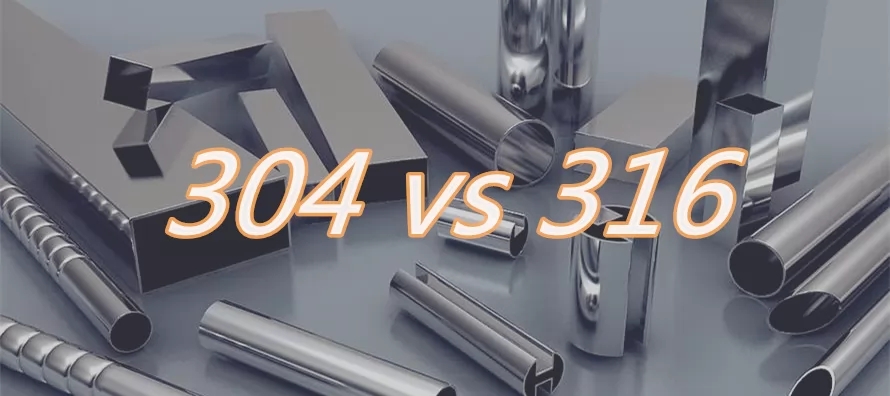304 vs 316 Stainless Steel Casting
304 and 316 stainless steel castings are widely used in scenes that require corrosion resistance. Of course, although they are called stainless steel castings, wear and corrosion are only a matter of time, but they are still an excellent solution in harsh environments and can provide durable products in many areas.

304 stainless steel castings
304 stainless steel is the most common type of steel. As a widely used steel, it has good corrosion resistance, heat resistance, low-temperature strength, and mechanical properties; it has good hot workability such as stamping and bending, and no heat treatment hardening phenomenon (non-magnetic, Use temperature -196℃~800℃).
Scope of Application
Household products (part of the tableware, cabinets, indoor pipelines, water heaters, boilers, bathtubs)
Auto parts (windshield wipers, mufflers, molded products)
Medical equipment, building materials, chemistry, food industry, agriculture, ship parts, etc.
316 Stainless Steel Castings
Due to the addition of molybdenum to 316 stainless steel, its corrosion resistance, atmospheric corrosion resistance, and high-temperature strength are particularly good. It can be used under harsh conditions; it has excellent work hardening properties (non-magnetic). When choosing austenitic stainless steel for marine applications, 316 stainless steel is generally considered to be one of the most suitable choices
Scope of Application
Equipment used in seawater, chemical, dye, paper, oxalic acid, fertilizer, and other production equipment;
Photography, food industry, coastal facilities, ropes, CD rods, bolts, nuts.
Common Applications of 304 and 316
304 and 316 stainless steel castings are widely used in everything from construction, medical treatment to food equipment. Stainless steel castings are very suitable for use in environments with high hygiene requirements, just like the examples of medical and food equipment mentioned above. For one thing , they will not react with corrosive acids. At the same time, surgical instruments and tableware made of stainless steel are easy to clean and disinfect.
Another reason for using stainless steel is that they do not require powder coating to resist corrosion and can maintain a beautiful appearance.
Difference Between 304 and 316 Stainless Steel
The types of stainless steel can be divided into 5 types: austenite, ferrite, martensite, duplex (a mixture of ferrite and austenite), and PH-precipitation hardening (martensite, semi-austenite, or Austenite). Due to the nickel content, AISI 304 and AISI 316 have austenitic microstructures. We skip the structural differences and directly understand how the structure affects the mechanical properties of the material.
The characteristics of austenitic stainless steel are:
- Excellent corrosion resistance under normal or slightly corrosive environment
- Excellent performance at low temperatures
- Performs well under high temperature
- Easy to harden
- Good ductility and formability
- Excellent weldability
- Very suitable for a hygienic environment
- Non-magnetic
| Chemical Composition | ||
| Grades | 304 | 316 |
| Carbon | C:≤0.08 | C :≤0.08 |
| Manganese | Mn :≤2.0 | Mn:≤2.00 |
| Phosphorus | P :≤0.035 | P :≤0.035 |
| Sulfur | S :≤0.03 | S :≤0.030 |
| Silicon | Si :≤1.0 | Si:≤1.00 |
| Nickel | Ni :8.0~10.5 | Ni:10.00~14.00 |
| Chromium | Cr :18.0~20.0 | Cr:16.00~18.50 |
| Performance comparison of 304 and 316 | ||
| Material | 304 | 316 |
| Tensile strengthσb(MPa) | ≥520 | ≥520 |
| Conditional yield strength σ0.2 (MPa) | ≥205 | ≥205 |
| Elongation δ5 (%) | ≥40 | ≥40 |
| Reduction of area ψ (%) | ≥60 | ≥60 |
| Hardness | ≤187HB,≤90HRB,≤200HV | ≤187HB,≤90HRB,≤200HV |
| Density 20℃ g/cm3 | 7.93 | 7.93 |
| Melting point (℃) | 1398~1454 | 1398-1420 |
304 and 316 Stainless Steel Castings, Which One to Choose?
There is no fixed answer. Generally speaking, if the use environment is salty or acidic, choose AISI316, which is the main and clearest dividing line between the two stainless sheets of steel. What is the working temperature used? The high temperature will accelerate corrosion , so higher grades are more suitable. What is your budget? If AISI 316 is not necessary, AISI 304 will be cheaper. The cost of the former is about 25% higher than the latter.






